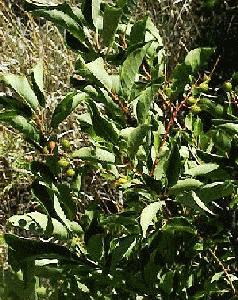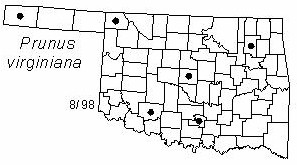
Large shrub or small tree to 10 m (30 ft) tall. Crown irregular. Bark dark gray to brown-black and furrowed. Twigs red-brown with pale lenticels, glabrous. Leaves alternate, simple; oval, oblong, or obovate in shape, 2-10 cm (0.8-4 in) long and 1.3-5 cm (0.5-2 in) wide; glabrous,dark green above, paler beneath; rounded or cuneate at base, acuminate or acute at apex, margins sharply serrate; petiole about 1.3 cm (0.5 in) long, slender, 2 glands near apex. Flowers in racemes, 7.5-15 cm (3- 6 in) long, glabrous; flowers 0.6-0.8 cm (0.2-0.3 in) in diameter; calyx-tube 5 lobed.; petals 5, white.; styles 1; stamens; flowers appear from April to July. Fruits drupes, 0.6-0.8 cm (0.2-0.3 in) in diameter, globose, dark red to nearly black; fruits mature July to September.
Distribution: Chokecherry is found in much of the U. S. and southern Canada except for the coastal plain. Rare in Oklahoma.
Habitat: rocky slopes and sand dunes.
Comments: Prunus is the classical name for European plums; virginiana refers to the state where first collected. Prussic (hydrocyanic) acid is found in the bark, leaves and pits of chokecherry. Cattle have died from eating chokecherry.
Horticulture: Infrequently used as an ornamental. Occasionally planted for erosion control.
Food uses: The fruit is used to make jellies and jams. Chokecherry provided a staple for Native American tribes. The pulp and kernels of the fruit were ground together and made into patties or balls. This ground product could also be combined with buffalo meat and fat to make pemmican. The fruits were also dried. The Prussic acid in chokecherry pits is neutralized by boiling or drying. The bark can be used as a tea.
Medicinal uses: Native American tribes made use of both the bark and fruits of chokecherry in medicinal preparations. For example, chokecherry juice was used to treat sore throat and diarrhea. Tea made from the bark was used as a cold remedy. Tea made from chokecherry roots was used as a sedative and stomach remedy. The bark has been used as a flavoring for cough syrups.
Wildlife benefits: The fruits of chokecherry are eaten by several species of birds.
NWI status: FACU-, FAC.
Distribution in Oklahoma: 
BACK
NEXT
RETURN TO INDEX
Last update: 9/15/99
 Go to Oklahoma Biological Survey Home Page
Go to Oklahoma Biological Survey Home Page
 Disclaimer
Disclaimer